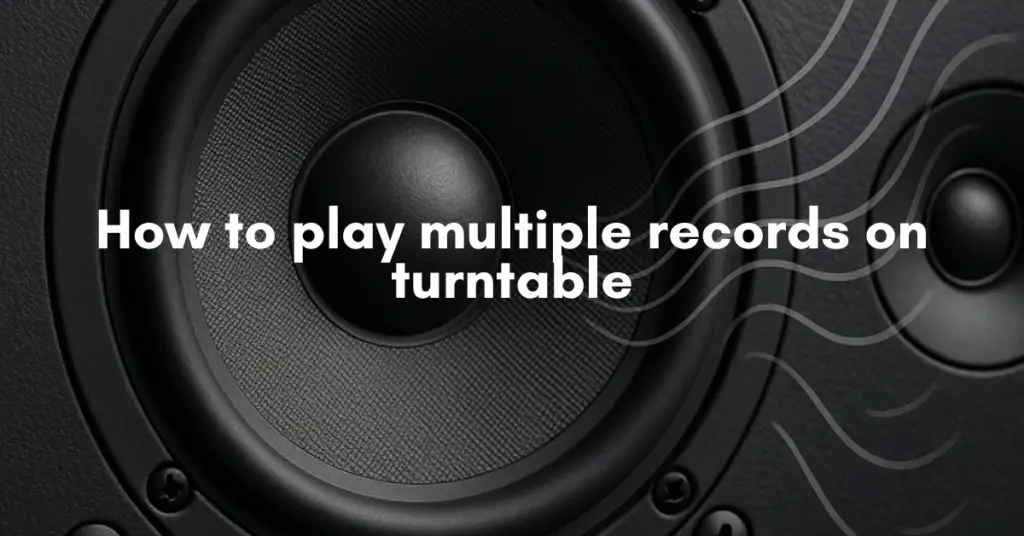Modern turntables are designed to play one record at a time, but earlier generations of record players included mechanisms that allowed users to play multiple vinyl records automatically. Today, if you want uninterrupted playback of several records, you need to understand the differences between vintage stacking systems and the alternatives available with modern equipment. Playing multiple records isn’t as simple as placing them one on top of another—in fact, that can damage vinyl. This article explains how it was done historically and what safe options exist today.
1. Understand That Modern Turntables Play One Record at a Time
Most contemporary turntables—Audio-Technica, Pro-Ject, Rega, Technics, Sony, etc.—are single-disc players. Their tonearms, platters, and tracking systems are engineered for precision. This means:
-
You cannot stack records directly on the platter
-
The tonearm cannot adjust height automatically
-
Stacking can damage grooves and cause mistracking
So, on a modern deck, you can only load one record at a time.
2. Use a Vintage Turntable With a Multi-Record Changer
If your goal is to play multiple records sequentially without manual swapping, the only true mechanical method is to use a vintage record changer, also known as a multi-record stacker.
These machines were designed with:
-
A tall stacking spindle
-
An automatic drop mechanism
-
A tonearm that lifts and resets for each record
How record changers work:
-
You stack several records (typically 6–8) on the spindle.
-
The turntable plays the top record.
-
Once the side is finished, the tonearm lifts and returns.
-
The next record drops onto the platter.
-
The tonearm automatically moves to the beginning.
This allows hours of continuous play from a stack of singles or LPs.
Brands known for high-quality changers:
-
Dual
-
Garrard
-
RCA Victor
-
Magnavox
-
Zenith
If you want authentic multi-record playback, a vintage changer is the proper tool.
3. Learn the Limitations of Record Changers
Although convenient, changers come with drawbacks:
-
Records rub together when stacked
-
Potential long-term groove wear
-
Mechanisms require maintenance
-
Not ideal for valuable or audiophile vinyl
-
Heavy tonearms can accelerate record wear
Collectors often avoid using changers with rare records, but they remain popular for casual listening and nostalgic appeal.
4. Modern Alternatives for Playing Multiple Records
If you want to play several records in a row without using a vintage changer, you have a few safe methods:
A. Create a “vinyl playlist” with manual swapping
The most common method:
-
Pre-select your records
-
Place them beside the turntable
-
Swap them manually between sides
While not automatic, this preserves sound quality and keeps records safe.
B. Use two turntables (DJ setup)
DJs often use:
-
Two turntables + a mixer
-
Alternating playback between decks
This allows continuous music without pause. While not stacking, it is a practical method to chain vinyl playback.
C. Digitize your vinyl for uninterrupted playback
If your goal is convenience rather than pure analog playback:
-
Rip your vinyl using a USB turntable or audio interface
-
Create a digital playlist
-
Play the digital versions uninterrupted
This preserves the vinyl sound while eliminating manual swapping.
D. Use an automatic turntable (single record at a time)
Some turntables are fully automatic:
-
Press START
-
Tonearm lifts, plays the entire side, and returns
-
You still need to flip/swap manually, but the operation is simpler
Fully automatic models speed up the process even if they cannot stack.
5. Why You Should Never Stack Records on a Modern Turntable
Stacking vinyl directly on a modern platter is unsafe because:
-
Tonearm height is fixed
-
Groove tracking angles change
-
Records can slide and scratch each other
-
Weight can warp the bottom record
-
Sound quality becomes poor
-
Possible stylus and cartridge damage
Always use a single record at a time unless using a true record changer.
6. What About Modern Turntables With “Stacking Spindles”?
A few retro-inspired brands have reintroduced changers or stacking attachments, but these are not common. Most high-fidelity turntable manufacturers avoid stacking entirely because it compromises sound quality.
If you do find a modern unit with a stacking spindle:
-
Ensure it is designed specifically for multi-record play
-
Never improvise your own stacking method
Conclusion
Playing multiple records on a turntable depends on the equipment:
-
Modern turntables: Play only one record at a time (no stacking)
-
Vintage record changers: Can play multiple records automatically through a stacking spindle
-
DJ setups or manual swapping: Allow continuous music without stacking
-
Digitized vinyl: Provides the longest uninterrupted playback
If your goal is authenticity and convenience, a vintage multi-record changer is the only device designed for safe multi-record playback. If your goal is sound quality and record preservation, playing one record at a time on a modern turntable remains the best option.

